
The Mustelidae are a diverse family of carnivoran mammals, including weasels, badgers, otters, polecats, martens, grisons, and wolverines. Otherwise known as mustelids, they form the largest family in the suborder Caniformia of the order Carnivora with about 66 to 70 species in nine subfamilies.

The American black bear, or simply black bear, is a species of medium-sized bear endemic to North America. It is the continent's smallest and most widely distributed bear species. It is an omnivore, with a diet varying greatly depending on season and location. It typically lives in largely forested areas but will leave forests in search of food and is sometimes attracted to human communities due to the immediate availability of food.

The cougar, also known as the panther, mountain lion, catamount and puma, is a large cat native to the Americas. It inhabits North, Central and South America, making it the most widely distributed wild, terrestrial mammal in the Western Hemisphere, and one of the most widespread in the world. Its range spans the Yukon, British Columbia and Alberta provinces of Canada, the Rocky Mountains and areas in the western United States. Further south, its range extends through Mexico to the Amazon Rainforest and the southern Andes Mountains in Patagonia. It is an adaptable generalist species, occurring in most American habitat types. It prefers habitats with dense underbrush and rocky areas for stalking but also lives in open areas.
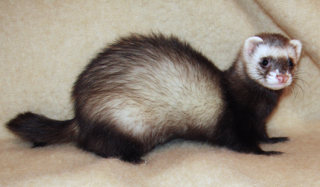
The ferret is a small, domesticated species belonging to the family Mustelidae. The ferret is most likely a domesticated form of the wild European polecat, as evidenced by the ferret's ability to interbreed with European polecats and produce hybrid offspring. Physically, ferrets resemble other mustelids because of their long, slender bodies. Including their tail, the average length of a ferret is about 50 cm (20 in); they weigh between 0.7 and 2.0 kg ; and their fur can be black, brown, white, or a mixture of those colours. The species is sexually dimorphic, with males being considerably larger than females.

The black-footed ferret, also known as the American polecat or prairie dog hunter, is a species of mustelid native to central North America.
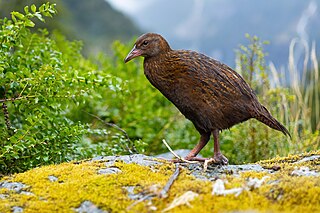
The weka, also known as the Māori hen or woodhen is a flightless bird species of the rail family. It is endemic to New Zealand. Some authorities consider it as the only extant member of the genus Gallirallus. Four subspecies are recognized but only two (northern/southern) are supported by genetic evidence.

The Philadelphia Zoo is a zoo located in the Centennial District of Philadelphia on the west bank of the Schuylkill River. It was the first true zoo in the United States; it was chartered by the Commonwealth of Pennsylvania on March 21, 1859, but its opening was delayed by the Civil War until July 1, 1874. The zoo opened with 1,000 animals and an admission price of 25 cents. For a brief time, the zoo also housed animals brought to U.S. from safaris by the Smithsonian Institution, which had not yet built its National Zoo.
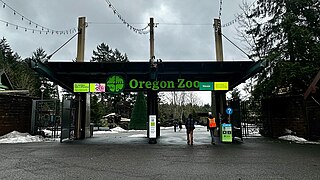
The Oregon Zoo, originally the Portland Zoo and later the Washington Park Zoo, is a zoo located in Washington Park, Portland, Oregon, approximately 2 miles (3.2 km) southwest of downtown Portland. Founded in 1888, it is the oldest zoo west of the Mississippi River.
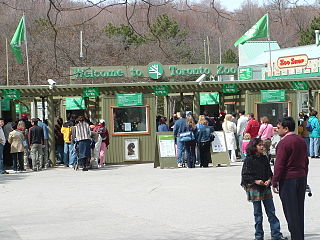
The Toronto Zoo is a zoo located in Toronto, Ontario, Canada. Encompassing 287 hectares, the Toronto Zoo is the largest zoo in Canada averaging around 1.2 million visitors a year. The zoo is divided into seven zoogeographic regions: Indo-Malaya, Africa, Americas, Tundra Trek, Australasia, Eurasia, and the Canadian Domain. Some animals are displayed indoors in pavilions and outdoors in what would be their naturalistic environments, with viewing at many levels. The zoo also has areas such as the Kids Zoo, Waterside Theatre, and Splash Island. The zoo has one of the most taxonomically diverse collection of animals on display of any zoo worldwide and is currently home to over 3,000 animals representing over 300 species. The zoo is open to the public every day of the year.

Omaha's Henry Doorly Zoo and Aquarium is a zoo in Omaha, Nebraska. It is accredited by the Association of Zoos and Aquariums and a member of the World Association of Zoos and Aquariums. In August 2014, TripAdvisor rated it the "world's best zoo", ahead of the San Diego Zoo and Loro Parque, based on an algorithmic assimilation of millions of reviews for 275 major zoos worldwide.

The Wilder Institute/Calgary Zoo is located in Bridgeland, Calgary, Alberta, Canada, just east of the city's downtown and adjacent to the Inglewood and East Village neighborhoods. It is accessible via Calgary's C-Train light rail system, by car via Memorial Drive, and by bicycle and footpath via the Bow River pathway. A large portion of the zoo is located on St. George's Island in the Bow River.
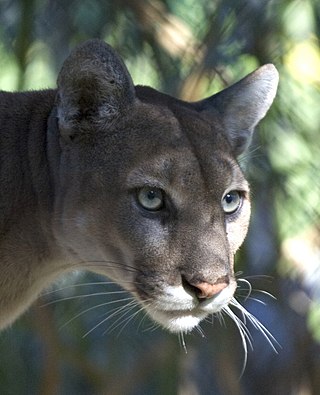
The Florida panther is a North American cougar population in South Florida. It lives in pinelands, tropical hardwood hammocks and mixed freshwater swamp forests. Its range includes the Big Cypress National Preserve, Everglades National Park, Florida Panther National Wildlife Refuge, Picayune Strand State Forest, as well as rural communities in the counties of Collier, Hendry, Lee, Miami-Dade, and Monroe County. It is the only confirmed cougar population in the Eastern United States, and currently occupies 5% of its historic range. As of 2024, about 200 individuals are left in the wild.

The North American cougar is a cougar subspecies in North America. It is the biggest cat in North America. And the second largest cat in the New World. It was once common in eastern North America and is still prevalent in the western half of the continent. This subspecies includes populations in western Canada, the western United States, Florida, Mexico and Central America, and possibly South America northwest of the Andes Mountains. It thus includes the extirpated eastern cougar and extant Florida panther populations.
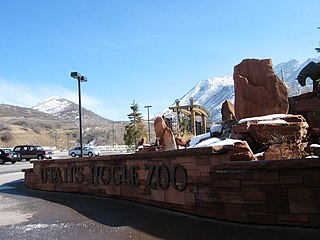
Located at the mouth of Salt Lake City's Emigration Canyon, Utah's Hogle Zoo is a 42-acre (17 ha) Association of Zoos and Aquariums (AZA) and the World Association of Zoos and Aquariums (WAZA) accredited facility. Hogle Zoo is one of the largest zoos in the Intermountain West, and houses over 800 animals representing 250 species.
Pacific International Enterprises (PIE) was an American film production company and film distributor, founded by Arthur R. Dubs as a producer of family films. Pacific International Enterprises was a privately held company that had been in business for over thirty years as "A Universal Force in Family Film Entertainment". Their films have been continually licensed and re-licensed for television by various channels such as HBO, Disney, TNT, CBS and in over 100 countries worldwide. Many of the company's movies were filmed on location with outdoor scenery shots such as the state of Oregon in Sacred Ground, the state of Utah in Windwalker and the state of Colorado for the three films of the Wilderness Family for example.

Land of the Tiger is a BBC nature documentary series exploring the natural history of the Indian subcontinent, first transmitted in the UK on BBC Two in 1997. The production team covered the breadth and depth of India, from the Himalayan mountains in the north to the reef-fringed islands of the Indian Ocean, to capture footage of the country's wild places and charismatic wildlife.
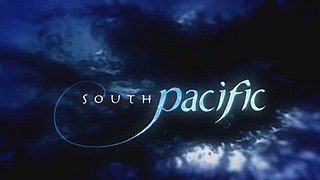
South Pacific is a British nature documentary series from the BBC Natural History Unit, which began airing on BBC Two on 10 May 2009. The six-part series surveys the natural history of the islands of the South Pacific region, including many of the coral atolls and New Zealand. It was filmed entirely in high-definition. South Pacific was co-produced by the Discovery Channel and the series producer was Huw Cordey. It is narrated by Benedict Cumberbatch. Filming took place over 18 months in a variety of remote locations around the Pacific including: Anuta, Banks Islands, French Frigate Shoals, Papua New Guinea, Palmyra, Kingman Reef, Tuvalu, Palau, Caroline Islands, Tuamotus and Tanna Island in Vanuatu.

An exotic pet is a pet which is relatively rare or unusual to keep, or is generally thought of as a wild species rather than as a domesticated pet. The definition varies by culture, location, and over time—as animals become firmly enough established in the world of animal fancy, they may no longer be considered exotic.

The fauna of the U.S. state of California may be the most diverse in the United States. Of the lower 48 contiguous states, California has the greatest diversity in climate, terrain, and geology. The state's six life zones are the lower Sonoran (desert); upper Sonoran ; transition ; and the Canadian, Hudsonian, and Arctic zones, comprising California's highest elevations. California's diverse geography gives rise to dozens of ecosystems, each of which has its own native plants and animals. California is a huge state, the third largest in the U.S., and ranges broadly in habitats.
The Vietnam ferret-badger is a member of the family Mustelidae native to Vietnam. It was described in 2011 and is known from only two specimens.


















